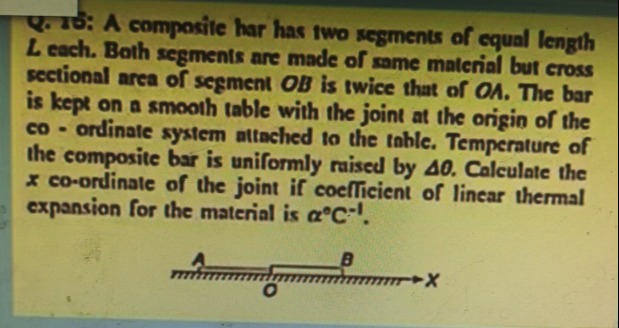Question
Question: A composite har has two segments of equal length L each. Both segments are made of same material but...
A composite har has two segments of equal length L each. Both segments are made of same material but cross sectional area of segment OB is twice that of OA. The bar is kept on a smooth table with the joint at the origin of the co-ordinate system attached to the table. Temperature of the composite bar is uniformly raised by Δθ. Calculate the x co-ordinate of the joint if coefficient of linear thermal expansion for the material is \alpha$$^\circC−1.

-3LαΔθ
Solution
The composite bar is on a smooth table, so the net external horizontal force is zero. Thus, the center of mass of the bar remains at its initial position.
Alternatively, we can consider the equilibrium of forces at the joint. Due to the different cross-sectional areas, the stresses developed in the two segments will be different when they are joined and undergo thermal expansion.
Let the initial position of segment OA be from x=−L to x=0, and segment OB be from x=0 to x=L. The joint is at x=0. Let the x-coordinate of the joint after the temperature rise be xj. The strain in segment OA is ϵOA and in segment OB is ϵOB. The total strain is the sum of thermal strain and mechanical strain: ϵ=αΔθ+σ/E. The displacement of the joint from the initial position of A is xj−(−L)=xj+L. This is the final length of OA, L(1+ϵOA). xj+L=L(1+ϵOA)⟹xj=LϵOA. The displacement of the joint from the initial position of B is xj−L. This is the negative of the final length of OB, −L(1+ϵOB). xj−L=−L(1+ϵOB)⟹xj=L−L(1+ϵOB)=−LϵOB. Thus, ϵOA=xj/L and ϵOB=−xj/L.
Let σOA and σOB be the stresses in segments OA and OB, respectively. The force equilibrium at the joint gives σOAA+σOB(2A)=0, so σOA=−2σOB. Substituting the strain components: ϵOA=αΔθ+σOA/E⟹xj/L=αΔθ+σOA/E. ϵOB=αΔθ+σOB/E⟹−xj/L=αΔθ+σOB/E. Subtracting the two equations: 2xj/L=(σOA−σOB)/E⟹σOA−σOB=2Exj/L. Substituting σOA=−2σOB: −2σOB−σOB=2Exj/L⟹−3σOB=2Exj/L⟹σOB=−2Exj/(3L). Then σOA=−2σOB=4Exj/(3L). Substitute σOA into the first strain equation: xj/L=αΔθ+(4Exj/(3L))/E=αΔθ+4xj/(3L). xj/L−4xj/(3L)=αΔθ. (3xj−4xj)/(3L)=αΔθ. −xj/(3L)=αΔθ. xj=−3LαΔθ.
The final answer is −3LαΔθ.
